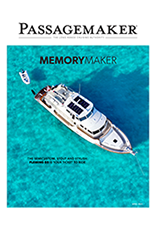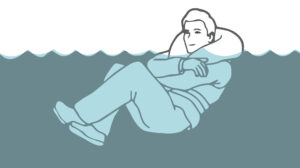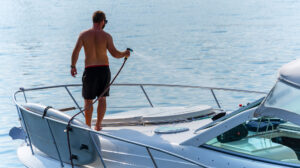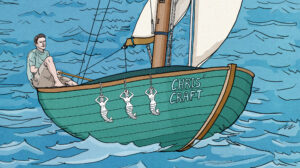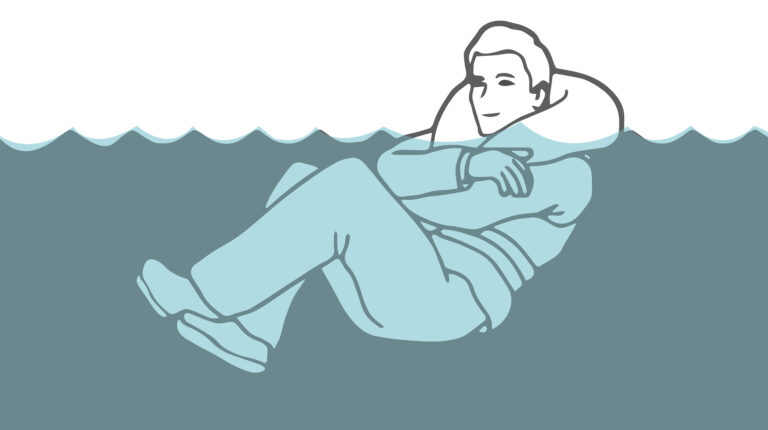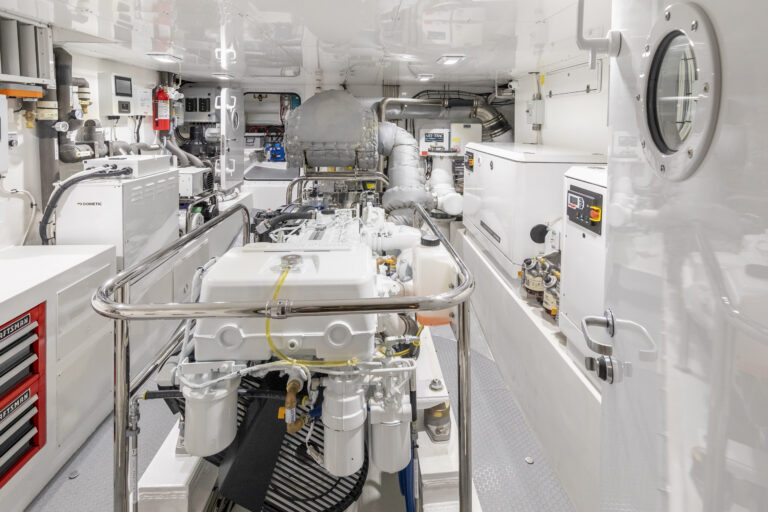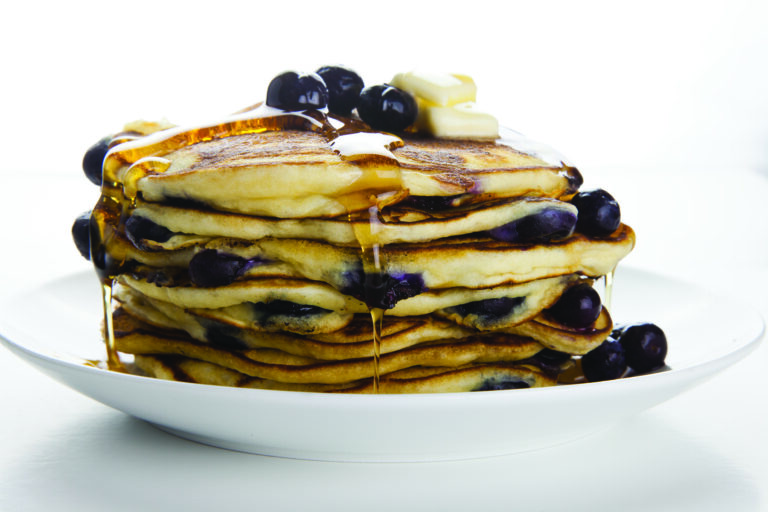It’s a common scene: Night has fallen, you’re in an unfamiliar anchorage, and though you’ve studied the maps and charts and gotten the lowdown from other boaters, you still have to decide which is the best way to anchor.
Boating demands decision-making on a daily, sometimes hourly, basis. You can plan a route months in advance, but until you’re on the water facing the three main factors—the craft, the crew, the climate—you don’t really know what you’re in for. Decision-making is stressful. It’s not, “Where do you want to eat dinner tonight?” It’s more like, “There are five-foot waves but we need to get back by Monday. Should we suck it up and make the 13-hour push to get home, or should we hunker down and wait?”
Experienced boaters have cultivated a style and finesse for making decisions. They use their instinct, information, and experience. But as we all know, experience comes with a lot of mistakes.
In 2015, my husband, Mark, and I and our three young children explored Lake Superior for three weeks aboard our 38-foot Marine Trader trawler, Mazurka. (“Grown Free,” March 2016.) The trip built confidence in ourselves, our boat, and our crew.

So for 2016, we decided for three-week encore, but with a wide-open itinerary to match the Lake Superior landscape. We decided only on a firm departure date, and the first three stops: the Apostle Islands, Grand Marais, Minnesota, and Thunder Bay, Ontario. After that, who knew where we might go? On past trips, we hit a perfect groove, making decisions on the fly, going with the flow, and open to adventure without a set course. It’s glorious.
This did not turn out to be one of those trips.
We also may have been too ambitious. Almost every place we visited was new to us. We also had our crew to consider: two adults, three little kids, a black tank that filled up in four days, and freshwater tanks that needed refilling every five days.
A few days before our departure, a major storm roared through northern Minnesota, uprooting trees and knocking down power lines, leaving thousands of people without power. With another storm bearing down, and the threat of a dysfunctional basement sump pump, Mark bought a float switch and rigged up a battery-operated Rule 3600 bilge pump for a backup sump.
Each day was fraught with decisions and questions: What if the power wasn’t restored? Would we risk leaving before our house had electricity? How long would it take to restore it? Would we have to change course so soon?
Finally, after four days, the we had power, so we skipped the Apostles and headed straight for Grand Marais, Minnesota, a sweet town to visit, with plenty of shops, restaurants, and nature to explore within walking distance of the marina.

We had reserved our slip and called ahead to let them know we’d be in around 9:30 p.m., but when we arrived, a motorcruiser was parked in our spot. The marina was closed, and all the slips were filled. Where do we go now? Sometimes, someone else magically appears and makes the decision for you. A sailor came out on deck. “I’d just park at the gas dock tonight,” he advised.

The next morning the harbor master greeted us, and the other boat owner apologized, saying he would move that morning. I overheard the big-boat captain asking the harbor master, “Are they in a hurry to get over here?” To which the harbor master replied, “It’s a family boat.” Which pretty much sums it up. We had three kids—ages 6, 4, and 2—on a boat that goes six knots. Were we in a hurry to get anywhere?
Well, sort of. We had Canadian waters to explore, but the weather shifted again, bringing small-craft advisories, and locking us into Grand Marais for four nights. Weather is the ultimate decision-maker, though accepting it as such can be another matter.
This was our first time cruising internationally, and our research showed that around the sparsely populated Lake Superior, there are only a few places to clear customs: Thunder Bay, entering Canada, and Isle Royale, Grand Portage, or Grand Marais on our return. We also knew we could not hang out in Canadian waters without clearing customs first. So instead of exploring the enticing islands around the U.S./Canadian border, we hightailed it to Thunder Bay.
We learned later that we could have gotten clearance for remote border passage before we left. Our mistake was not doing enough research. If I had done just a bit more digging, I would have discovered there was an easier way for American boaters to cross to Canadian waters.
A LONG STAY IN THUNDER BAY
We arrived in Thunder Bay, tired and strung out. I was anxious about being in an unfamiliar marina in a different country, the newness of clearing customs (which actually consisted of a 10-minute phone call), and managing our three small crew members. The harbor master told us that if we stayed seven nights in the marina, we could get a discount. On the spot, we agreed and handed over the credit card.
About two hours later once we had settled in and relaxed a bit, we regretted the decision made so quickly. I didn’t want to be in a city, I wanted to be at a remote wilderness anchorage, like the previous night we had spent at Clark Bay, the last anchorage before rounding Pigeon Point into Canada. I prefer the solitude of thinking we were the only people in the world. In Clark Bay, we had spent the night listening to the loons and the zombie-like mosquitoes pounding at the tightly sealed windows and doors and feeling the thick, white Milky Way above our heads. Now we were in a metropolis of more than 100,000 people for an entire week? We could always leave early, but we were still out the money. And how had we made that decision so quickly, anyway?
In the end, staying a week in Thunder Bay worked out fine. The wind and waves were high most days, and small-craft advisories kept boats tucked into their slips. We did spend a night anchored in Sleeping Giant Provincial Park, Sawyer Bay, where we hiked a route with miles of the largest, ripest thimbleberries we had ever seen—our lips stained dark red and our legs scratched from the brambles we’d braved to pick the berries. We also explored the beautiful waterfront at Thunder Bay, including the Splash Pad, which is a children’s play center downtown. But after a few days, I kept thinking: I could be doing this at home.

Morale was low. I was restless and complaining, not content with our location. Mark was trying to make me happy while also completing work from his job back home. Four year-old Esther was overtired and having daily temper tantrums. Six year-old Rafael was fine building Legos all day long. Two year-old Anton was the happiest of all, but that’s his natural disposition.
We threw off the Thunder Bay lines for Tee Harbour and spent two nights at Sleeping Giant, hiking, swimming, learning to skip rocks, and a bonus double rainbow proved to be good medicine for the crew.
Local boaters encouraged us to head up the shoreline to explore Loon Harbour, but we were nearing the end of the second week, with only another week to go. Did we want to venture farther north, knowing we’d have to backtrack all this way?
SHOULD WE STAY OR GO?
We decided to head back to the U.S., and Isle Royale seemed the closest, most interesting destination. With its variety of shoals, small islands and inlets, Isle Royale—the least-visited National Park in the U. S.—is an enormous, wonderful puzzle for boaters. The Windigo ranger station at Washington Harbor was new to us, and without previous experience, we had to rely heavily on our navigation tools.
We use a Furuno chart plotter/radar with C-Map, Navionics, and iNavx, which connect to a GPS via inReach. We also have Richardson’s chartbook and cruising guide of Lake Superior, and Bonnie Dahl’s The Superior Way, considered the bible for the Lake Superior boater. Mark needed all of these to maneuver us safely into Washington Harbor. Navionics showed obstacles on the course—shoals and rocks—that the Furuno C-Map did not, and Bonnie’s book informed us of both the history of the area and areas of danger, especially considering the direction of the sun and wave height, which can make shoal-spotting difficult.
On our way in we saw the results of others’ poor decision-making, like the sunken ship America, with its bow just a few feet beneath the surface near the North Gap into Washington Harbor.
The steamer America delivered people, mail, and other goods in the first part of the 20th century around northern Lake Superior. Under a full moon in June 1928, America’s new first mate misjudged shadows for shoreline and steered too far off the south shore, right over a reef. The grounding tore a gaping hole on the starboard side. Lifeboats were launched, with all the passengers and crew safely aboard, but efforts to beach the ship for salvage fell just 30 yards short of land.
Cruising right by America compelled us to buy Shipwrecks of Lake Superior at the Windigo gift shop, inspiring our nighttime reading and plenty of discussion about poor decision-making on the water. At our protected Beaver Island anchorage, we spent nearly a week of forced downtime at anchor, as thunderstorms and swelling seas buffeted the island. We played Go Fish and shipwright with our pile of Legos, each day deciding what our new course might be if and when we’d be able to leave.
We depended on the Zodiac to get to shore until one morning the 1994 Mercury 3.3-horsepower outboard motor failed to start. At first Mark thought it was contaminated fuel, an issue we saw during last year’s cruise. But after a few hours of failed attempts and new fuel, Mark made a wild guess and narrowed the problem down to a spark plug gap; it started up and ran well enough to make the mile-long run to Windigo for the next few days.
On shore, we hiked, picked berries, and listened to park ranger talks. On one hike, Rafael was in the lead, and as he turned a corner, there was a big rustling in the woods. He turned back, eyes wide, mouth open. “I just saw a moose,” he said. On the return hike, Esther, not to be outdone by her brother, forged ahead, and was rewarded when a black garter snake crossed her path.

DECISIONS, DECISIONS
When the storms finally cleared, we had just three days to get home to Duluth, Minnesota. We decided to make a run for the Apostle Islands, about 80 miles away.
The lake had spent the previous four days in upheaval, and 3- to 5-foot waves still battered us from every direction. At the helm, I started to yawn. Then came the headache, then the all-over body aches. I was seasick, so I stayed at the helm, where I could keep my eyes on the horizon, while below me, our kids on the forward deck laughed and leapt in the waves splashing up on them. Suddenly, I felt the boat being taken beyond my control, up on a crest, surfing, then being set down and righting itself. I panicked for a second. Then it happened again, and again. The next time Mark came up to the flybridge I told him about it.
“That’s a following sea,” he said. “Cool, huh?”
This lack of control can be one of the hardest and also most rewarding parts of boating: We make a decision, but we also have to surrender and let go of the outcome and see where the journey takes us.
At the beginning of the trip I asked to learn more about captaining Mazurka, its systems, and navigation. So, along with teaching me, Mark asked my input on a lot of things, and we started making more decisions together. But we have different levels of experience and knowledge, and sometimes, different instincts.
This past winter we met Gary and Jodi Bratton, who turned back from a trip across the Atlantic Ocean to Ireland when they got knocked down in a gale 700 miles out to sea and the steering went out. Rather than risk the journey, they decided to head back home and spend the winter living aboard their 47-foot Catalina 470, Country Dancer, in northern Minnesota. I asked Gary about how he and Jodi make their decisions together.
“One of us looks at it as a captain of a ship and ex-motorcycle rider; one of us looks at it as a grandmother and as a wife,” he said. “We have two very different views. It takes a long time to learn to respect the other person’s feelings, wishes, and insights. My wife also has very good instincts. If I ignore those, I do that at our mutual peril. We understand that there’s only one captain on the boat, but this captain has finally realized there are two very smart people on the boat. We don’t make very many unilateral decisions, ever. We’ve also learned the intuition thing—it’s not very scientific, but if you feel bad about something, listen—it doesn’t matter which one it is.”
In shared decision-making models, there is time to disseminate all the information to everyone, discuss all the options, and arrive at a consensus. Angèle and Jim Passe teach the Great Lakes Cruising Club School online class titled, “Sharing the Helm.” In making decisions together, they follow the model to be safe, comfortable, and happy.
“The only problem we joke about with this model,” Angèle said, “Is that if, indeed, we make the decision to go, and if, indeed, it turns out to be a bad situation, we can’t blame each other—we arrived to that decision together.”

APOSTLE ISLANDS
It felt a bit more comfortable in the Apostles, which were familiar and close to home, but we weren’t out of the woods yet and more decisions needed to be made. Our mistake here was letting our guard down too soon. We awoke to our last full day on the water with good weather, and an empty water tank. Another decision: Do we head home, or head over to the marina at Madeline Island to fill up, pump out, and get ice cream?
Maybe we just don’t know when to quit, but we went with the Madeline Island option. Three hours later we arrived in the marina, where you can camp out in a slip for a couple hours while you explore the town of La Pointe, Wisconsin, the only town in the Apostles. We strolled leisurely, the kids ate ice cream, and I stocked groceries for our final night aboard. I told the woman at the counter we were finishing three weeks on the boat with three little kids. “That’s a vacation?” she asks.
It was late afternoon, and faced with our final anchorage, I said to Mark, “Let’s keep it simple and just go around the island to Big Bay.” We hadn’t been there before, but it looked good on the map, not in the wind direction, with a gorgeous beach. He agreed. Turns out that Madeline Island is rather large, especially for a trawler going six knots. It took us nearly three hours to reach the anchorage. We were hungry, tired, and greeted at the mouth of Big Bay by another thunderstorm.
“Where do you want to go?” Mark asked me.
“Let’s anchor there,” I said, pointing off the starboard side.
“I think we should go over there,” he said, pointing off the port.

Since I was at the helm, he deferred to me, which says a lot about his character, but at the time, I was not so appreciative. I maneuvered between boats until I settled in on the perfect spot about 20 feet from the beach, clear of any other boats. When the anchor caught, we started to make dinner just as the sky ripped open and water gushed down. In a few minutes the clouds passed, and a full double rainbow appeared over the lake. Everyone came out to admire it, including our new neighbors, who were now less than 10 feet away and getting closer. “I think you guys have to move,” one of them called over, “Watch out for the deadhead.”
We moved to the spot Mark had originally wanted for its proximity to land and protection from rollers. I felt rotten for making a poor decision about anchoring and that Mark had known all along where to go. At the end of a long trip, when all you want to do is sit on a big, beautiful beach, having to take two shots at an anchorage while preparing dinner for five in a thunderstorm with floating deadheads is the last thing you want to do.
The biggest mistake of our trip, which we reasoned after our return, is that we had too many expectations, or, to be more specific, I had too many expectations. I wanted the adventure of exploring wilderness anchorages like we had the previous year, and conditions conspired to keep us in urban marinas. Even at the remote Isle Royale, our cruising and hiking was limited by weather. We tried to meet expectations, which is impossible to do, especially when so many factors—weather, craft, crew—are beyond our control. We didn’t make enough decisions beforehand, with the expectation that without a set itinerary, the trip would feel free. When it didn’t, and we were suddenly forced into making too many decisions, the everydayness of life took over, even in such beautiful locations.
So we have decided this: In the future, we’ll spend more time making decisions in advance and arrange a complete itinerary that takes into account contingency plans for weather, proximity to marinas, and the need for downtime. Not that we won’t be able to adapt and change course, but we need to have a course in mind. We’ll consider the question, “Could we just stay home to do this?” And if we’re not happy in a location, we’ll work together to decide when to change it, and when to accept that sometimes, the following sea just takes us. Sometimes the best we can do is relax and enjoy the ride.
As for managing expectations? Well, that’s a whole other problem.
That last night in Big Bay, rollers came in, and we spent the night rocking. Not the peaceful cradle that people like to imagine aboard a boat—nope, these were big rollers that came in off the lake and hit us one way, then bounced off shore and hit us again. Neither of us slept. Mark wanted to pull anchor at 2 a.m.
At 9 a.m. we were ready to go when Mark stalled in the engine room, puttering with the Ford Lehman. “I’ve been watching it the whole time…” he said. I had no idea there were any issues with the engine, because he hadn’t disclosed this information to me.
We made it home in one piece, without any mechanical problems, but a month later as we headed out for Labor Day weekend, our refined decision-making skills were put to the test. A half-hour underway Mark checked the engine. “I think the head gasket is blown,” he reported. We turned around and headed back. For the next six weeks, the engine sat torn apart for a top-end overhaul.
The decision to fix it was simple, albeit pricey.
Felicia Schneiderhan is the author of the memoir, Newlyweds Afloat: Married Bliss and Mechanical Breakdowns While Living on a Trawler.
